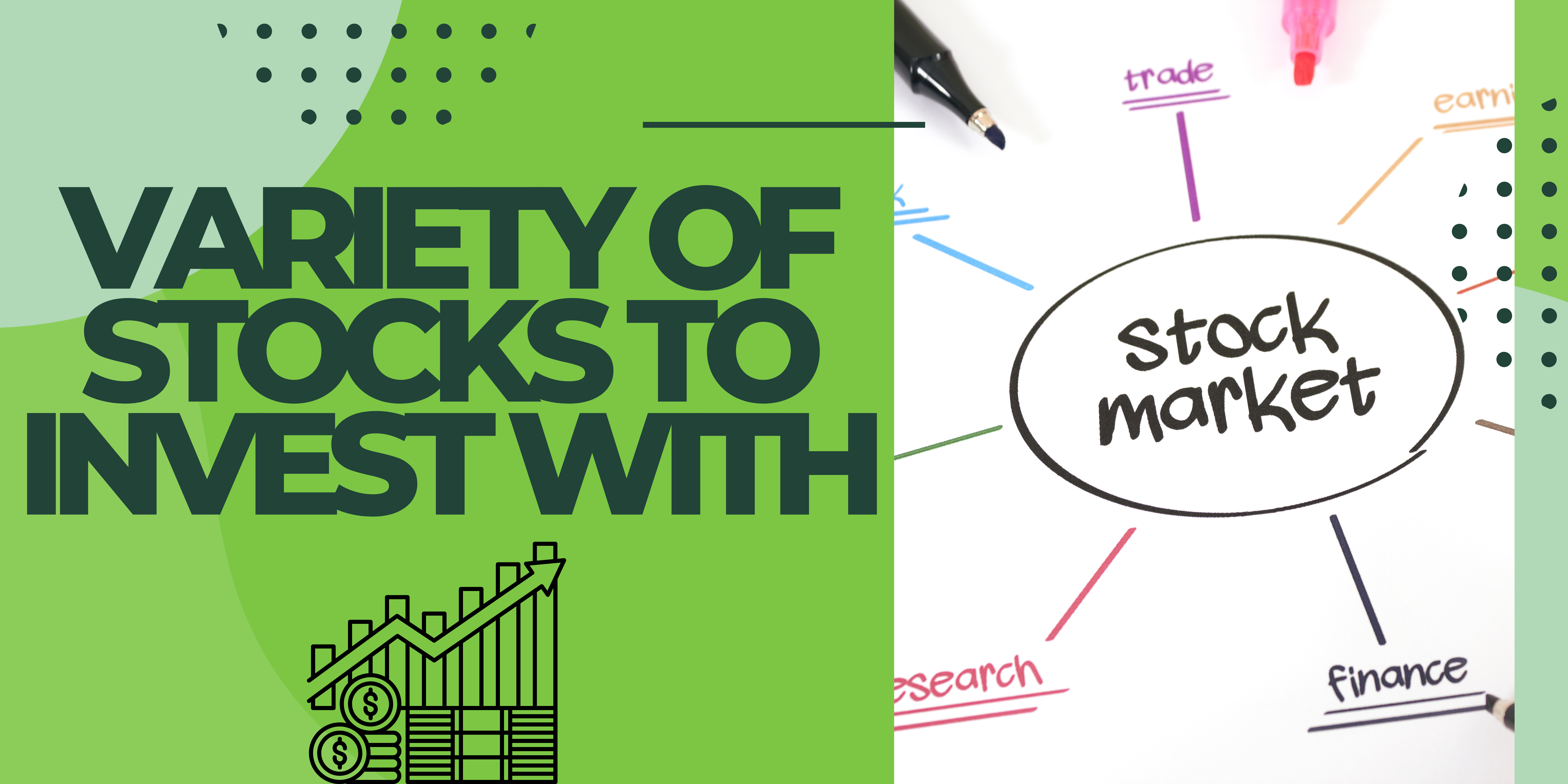No products in the cart.
Financial, Middle-aged adults, Stock Market
The Best Stocks to Invest in for Explosive Growth in 2023

TYPES OF STOCK YOU CAN BUY
Most people typically connect stocks with exchanged publicly traded shares that take place on stock exchanges. But it’s important for investors to be aware of the many share types that are available, understand their unique characteristics, and be able to spot the situations in which they might be a wise investment. We have included the various stock classifications below to help investors understand the several stock classes that are available to them.
Mins to Read: 8 minutes
Age: 25-55

You don’t need to be very smart in mathematics before entering the stock market. Knowledge is vital, but perseverance is more crucial since knowledge may be learned, but great things don’t come to those who give up. You won’t fail if you make a firm commitment to both learning from the best and from your errors. Never lose hope and have faith in yourself.
1. Common and Preferred Stock
Common stock makes up the majority of stock investments. Shareholders of common stock, which represents a component of a company’s ownership, are entitled to a proportionate share of the assets’ value in the event that the business is dissolved. Shareholders of common stock have theoretically limitless upside potential, but they also run the risk of losing everything if the business fails with no assets left over.
Differently, preferred stock grants owners the right to get a specific amount of money back in the event of a firm dissolution before common shareholders. Additionally, preferred shareholders are entitled to dividend distributions ahead of common shareholders. Overall, this leads to preferred stock having more in common with fixed-income bond investments than standard common stock as an investment. A corporation will frequently only sell common stock. This makes logical because stockholders typically want to acquire that.
2. Growth Stocks
Growth equities often carry higher levels of risk, but the potential rewards can be very alluring. Businesses with high and rising customer demand, particularly in relation to longer-term changes in society that encourage the use of their products and services, are successful growth equities. However, competition can be severe, and if competitors undermine a growth equity’s operations, it may swiftly lose popularity. Investors’ concern that long-term growth potential is dwindling can sometimes cause even a slight slowdown in growth to cause prices to drop quickly.
.
3. Value Stocks
Value stocks are thought to be more cautious purchases. They frequently are established, well-known businesses that have already developed into market leaders and so don’t have as much room to grow. However, they can be ideal options for people looking for more price stability while still obtaining some of the benefits of exposure to equities because they have dependable business structures that have withstood the test of time.
4. Income Stocks
Since most companies give out income in the form of dividends, income stocks are simply another name for dividend stocks. However, shares of businesses with more established business models and relatively fewer long-term growth potential are also referred to as income stocks. Income stocks are a popular among individuals in or close to retirement since they are ideal for conservative investors who need to withdraw cash from their investment portfolios right away.
4. Blue Chip Stocks
Stock categories exist that rely their decisions on perceived quality. Blue Chip firms are often the best of the best in the corporate world, dominating their respective industries and building solid reputations. Although they normally don’t offer the maximum profits possible, investors with lesser risk tolerance choose them because of their consistency.
6. IPO Stocks
When a business goes public, it offers shares of stock in an IPO (IPO). Before the company’s equity lists on the stock exchange, IPO stock is often allocated at a discount. Additionally, a vesting timetable might be included to stop shareholders from selling all of their shares at the start of trade. When referring to recently listed stocks, market analysts also use the term “IPO stocks.” Through the Nasdaq website, investors may keep an eye out for upcoming IPOs.
7. ESG Stocks
Environmental, social, and corporate governance (ESG) stocks place a strong emphasis on social justice, environmental preservation, and ethical business conduct. For instance, a company that pledges to cut its carbon emissions faster than industry and governmental targets or one that produces equipment for renewable energy infrastructure may be an ESG stock.
Millennials, a socially conscious generation that is more likely to invest in causes they believe in and support, have grown more popular with ESG equities in recent years. By including the Vanguard ESG U.S. Stock ETF (ESGV) to their portfolio, investors can gain access to ESG stocks.
8. Penny Stocks
Penny stocks, in contrast, are low-quality businesses with extremely low stock values, usually less than $1 per share. Penny stocks are susceptible to scams that can wipe out your entire investment due to their risky, speculative business practices. It’s critical to be aware of the risks associated with penny stocks.
You’ve probably heard that having a diverse portfolio is crucial for creating solid, reliable investments. As you make plans for variety, keep in mind that investing in companies with various market capitalizations, geographic locations, and investing strategies helps to create a portfolio that is well-balanced.
9. Defensive Stocks
In most economic and financial settings, defensive stocks often offer stable returns. These businesses typically market necessities like consumer goods, healthcare, and utilities. During a sell-off or bear market, defensive stocks may aid in preventing a portfolio from suffering significant losses. Value, income, non-cyclical, or blue-chip stocks can also be defensive investments. One of the defensive stocks in the core holdings of the Invesco Defensive Equity ETF is healthcare multinational Cardinal Health, Inc., a subsidiary of telecommunications behemoth AT&T Inc.
10. Cyclical Stock and Non-Cyclical Stock
National economies frequently experience expansionary and contractionary cycles, as well as boom times and busts. Investors refer to certain companies as cyclical stocks because they are more vulnerable to general business cycles.
Shares in businesses engaged in manufacturing, travel, and luxury products are examples of cyclical equities because a downturn in the economy might impair consumers’ capacity to swiftly make large purchases. However, when economies are robust, a surge in demand may cause these businesses to quickly recover.
Non-cyclical companies, usually referred to as secular or defensive stocks, don’t experience those significant fluctuations in demand. Grocery store companies are an example of non-cyclical equities since people still need to eat whether the economy is doing well or poorly. While cyclical stocks frequently thrive during robust bull markets, non-cyclical stocks typically do better during market downturns.
11. Safe Stocks
Safe stocks are those with share prices that fluctuate less than the entire stock market on an up-and-down basis. Safe companies, sometimes referred to as low-volatility equities, typically operate in sectors of the economy that are less subject to shifting economic conditions. Additionally, they frequently provide dividends, and this revenue can be used to counteract declining share values in trying times.

READ MORE RELATED BLOGS!
READ MORE AND SHARE!
TSOK Chronicles: Unleashing Passion, Dedication, and Excellence in 2024
2023 Your Practical Wedding Guide
Investments and Finance Ultimate Guide
If you like this article please share and love my page DIARYNIGRACIA PAGE Questions, suggestions send me at diarynigracia@gmail.com
You may also follow my Instagram account featuring microliterature #microlit. For more of my artworks, visit DIARYNIGRACIA INSTAGRAM


Peace and love to you.